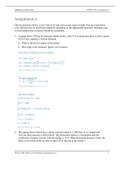STAT 2040 Notes
SUMMER
SEMESTER
OF 2020
, Descriptive Statistics
MEASURES OF CENTRAL TENDENCY
The sample mean I the ordinary
is
average
-
, ,
E Xi
↳
I = /n
middle value when data set ordered from smallest
largest
-
Median -
is the a is to
-
Mode -
is the most frequently occurring value
observations
Modal Class the class on a
histogram with the most
-
-
For skewed distributions the median
right mean >
-
-
For left skewed distributions the mean < median
-
-
For a perfectly symmetric distribution the mean median
-
=
The mean is more influenced by extreme observations
-
The median used as a descriptive measure
-
is
-
The mean is often used in statistical inference procedures
of the smallest and are removed before
largest observations
Trimmed Mean the mean
calculating
a certain
percentage
-
-
where different values
Weighted Mean weight
the calculation
-
are more in
given
-
MEASURES OF VARIABILITY
-
The deviation of a value from the mean is the value subtract the mean
-
A deviation is the distance from the mean
-
The sum of the deviations is always zero
Mean Absolute Deviation ( MAD) the distance from the
average mean
- -
El Xi I 1
↳ In
-
MAD =
( S2 ) distance from the mean
average squared
-
sample variance -
the
5)
↳
gz =
E ( Xi -
4h . I
-
The sample variance is used to estimate the population variance
standard Deviation the
square root of the variance
-
-
↳
s =
is = Min ,
The
larger the variance and standard deviation the the variability
greater
-
,
-
The empirical rule is used to estimate how many standard deviations a value is from the mean for a mound -
shaped
distribution
WHY DIVIDE BY N -
1?
-
sample mean and variance estimate the population mean 2nd variance
-
El Xi - *
Mn tends to underestimate the population variance
we lose one
degree of freedom when we estimate the population mean with the sample mean
-
, Z -
SCORES
An observation 's of how small that observation is relative to the other observations
2 score is a measure
large
-
-
or in
the data set
Xi
51g
-
z
-
.
=
An observation 's score tells us how many standard deviations that observation is above below the mean
-
2 -
or
-
Z -
scores are Uni Hess ,
have a mean of zero and a standard deviation of one
-
Empirical rule for mound shaped -
distributions
↳ 68% of I and I
scores lie between
~
z
-
-
↳ ~
95% of z scores lie between
-
-
22nd 2
↳ All or almost all 2 scores lie between
-
-
3 and 3
SUMMER
SEMESTER
OF 2020
, Descriptive Statistics
MEASURES OF CENTRAL TENDENCY
The sample mean I the ordinary
is
average
-
, ,
E Xi
↳
I = /n
middle value when data set ordered from smallest
largest
-
Median -
is the a is to
-
Mode -
is the most frequently occurring value
observations
Modal Class the class on a
histogram with the most
-
-
For skewed distributions the median
right mean >
-
-
For left skewed distributions the mean < median
-
-
For a perfectly symmetric distribution the mean median
-
=
The mean is more influenced by extreme observations
-
The median used as a descriptive measure
-
is
-
The mean is often used in statistical inference procedures
of the smallest and are removed before
largest observations
Trimmed Mean the mean
calculating
a certain
percentage
-
-
where different values
Weighted Mean weight
the calculation
-
are more in
given
-
MEASURES OF VARIABILITY
-
The deviation of a value from the mean is the value subtract the mean
-
A deviation is the distance from the mean
-
The sum of the deviations is always zero
Mean Absolute Deviation ( MAD) the distance from the
average mean
- -
El Xi I 1
↳ In
-
MAD =
( S2 ) distance from the mean
average squared
-
sample variance -
the
5)
↳
gz =
E ( Xi -
4h . I
-
The sample variance is used to estimate the population variance
standard Deviation the
square root of the variance
-
-
↳
s =
is = Min ,
The
larger the variance and standard deviation the the variability
greater
-
,
-
The empirical rule is used to estimate how many standard deviations a value is from the mean for a mound -
shaped
distribution
WHY DIVIDE BY N -
1?
-
sample mean and variance estimate the population mean 2nd variance
-
El Xi - *
Mn tends to underestimate the population variance
we lose one
degree of freedom when we estimate the population mean with the sample mean
-
, Z -
SCORES
An observation 's of how small that observation is relative to the other observations
2 score is a measure
large
-
-
or in
the data set
Xi
51g
-
z
-
.
=
An observation 's score tells us how many standard deviations that observation is above below the mean
-
2 -
or
-
Z -
scores are Uni Hess ,
have a mean of zero and a standard deviation of one
-
Empirical rule for mound shaped -
distributions
↳ 68% of I and I
scores lie between
~
z
-
-
↳ ~
95% of z scores lie between
-
-
22nd 2
↳ All or almost all 2 scores lie between
-
-
3 and 3










